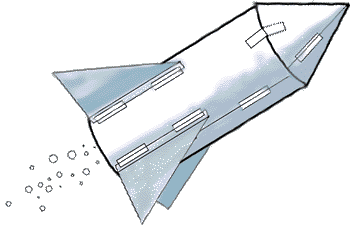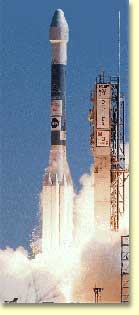
Build a Bubble-Powered Rocket!

Build a Bubble-Powered Rocket!
 Build your own rocket using paper and fizzing tablets! Watch it lift off. How high does your rocket go? Print this page for the instructions.
Build your own rocket using paper and fizzing tablets! Watch it lift off. How high does your rocket go? Print this page for the instructions.
|
| Suggestion: Find a grown-up to do this activity with you.
|
| Materials:
|
| Hints:
| The film canister MUST be one with a cap that fits INSIDE the rim instead of over the outside of the rim. Sometimes photography shops have extras of these and will be happy to donate some for such a worthy cause.
Keep in mind: Just like with real rockets, the less your rocket weighs and the less air resistance (drag) it has, the higher it will go.
|
| Making the Rocket
You must first decide how to cut your paper. You may cut it the short way or the long way to make the body of the rocket. There is no one right way to make a paper rocket. Try a long, skinny rocket or a short, fat rocket. Try a sharp nosecone or a blunt nosecone. Try it with fins or without fins. Experiment! Here's just one idea for how you might cut your whole rocket from one piece of paper:
Here are the basic steps:
Now work quickly on the next steps!
|
 So, Dr. Marc, how does the pop-rocket work?
So, Dr. Marc, how does the pop-rocket work?
When the fizzy tablet is placed in water, many little bubbles of gas escape. The bubbles go up, instead of down, because they weigh less than water. When the bubbles get to the surface of the water, they break open. All that gas that has escaped from the bubbles pushes on the sides of the canister.
Now when you blow up a balloon, the air makes the balloon stretch bigger and bigger. But the little film canister doesn't stretch and all this gas has to go somewhere!
Eventually, something has to give! So the canister pops its top (which is really its bottom, since it's upside down). All the water and gas rush down and out, pushing the canister up and up, along with the rocket attached to it.
Real rockets work kind of the same way. But instead of using tablets that fizz in water, they use rocket fuel.
| |

| Delta rocket similar to the one that launched the Deep Space 1 spacecraft from Cape Canaveral, Florida, in October 1998. |
| The rocket that launched Deep Space 1 on October 24, 1998, had four different kinds of engines. Some pushed the rocket off the ground. Then some helped it continue its climb into space. Others gave the Deep Space 1 spacecraft its final push away from Earth. But all of them forced a gas to shoot out of the rocket, thus pushing the rocket the other way.
We call this wonderful and useful fact the law of action and reaction. The action is the gas rushing out of the rocket. The reaction is the rocket taking off in the other direction. In other words, for every action there is an equal and opposite reaction. The rocket goes in the opposite direction from the gas, and the faster the gas leaves the rocket, the faster the rocket gets pushed the other way. You can also print out a 3-page Adobe Acrobat file of this activity.
| |
 |
 |
 |
 |
 |
 |
|
| |||||